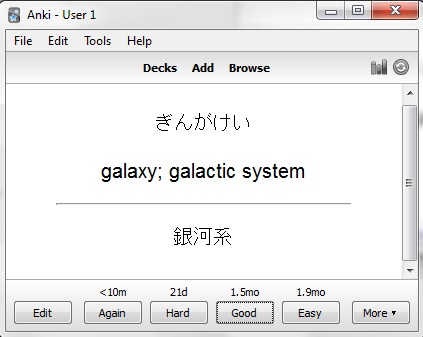I’m still studying kanji (Japanese characters. I’ll probably be studying kanji for the rest of my life). Today, I’ll introduce my simple method for practicing kanji.

These are some kanji drill books I bought a while back, covering all the kanji learned in the 5th and 6th grades in elementary school. At first, I was just writing the kanji over and over again in a separate kanji notebook and hoping it would stick. I made some paper flashcards, too, but couldn’t bring myself to consistently study them.
I eventually started entering the kanji from the practice books into Anki. Anki is a free flashcard program for your computer, and it’ll quiz you on cards on different days depending on how well you answer that you know the card (Good, Very Good, etc). Instead of making myself write the words and remember the meanings, like I was sort of doing before, I decided to work only on being able to write a kanji when I knew what the meaning was already. My Anki cards look like this:
Front:
Back:
The only time-consuming part is entering in the info for the flashcards in the first place–that takes a while. I copy and paste my definitions from Jisho.org, Google Translate, or Excite Jisho–whichever meaning seems to make more sense. I insert the stroke order onto the answer card sometime, which I borrow from Jisho.org (Jisho.org has images, not animations, for the stroke order of each kanji).
When a flashcard comes up saying something like “ぎんがけい galaxy; galactic system,” I write it in black on a half sheet of A4 scrap paper. When I miss a kanji, I write it in red a few times. Sometimes, I’ll try to write a mnemonic to help remember the kanji by, but only if it just comes to me right then.
Then, I just put the date at the bottom, and glue the top of the newest sheet to the one I used the last time I studied at that particular school. I got the idea from the evaluation cards my vice principal uses for the kids to write what they feel they’ve learned in English class. It’s also an easy thing to glance back at and look over just the kanji you missed before, although I haven’t been good about doing that.
It’s really easy to set aside a little time to do this each day, and it’s also a really easy way of measuring the kanji you’re learning. I can feel myself becoming a faster writer; I know you can always use your computer to write things, but when I’m at staff meetings, visiting students’ classes, or need to write on the spot for some reason, it’s nice to be able to write something right there instead of trying to look it up. Even though you can always just memorize and read the kanji without being able to write them, I think that being able to produce them yourself actually helps you remember kanji better, because you really have to recognize the differences yourself to be able to write them.
And finally, 6 hours of lovely study music!




Wow! Your organization and study skills are amazing!
I may listen to at least some of the study music at work this afternoon. Thanks! I don’t think I’ll be working on kanji though.
So diligent! :)
You can activate the white board on anki app to write kanji down. It helps to me, I write with a pen-like on my tablet. Thank you for the tips, try quizlet to. =P it is much faster to set terms, definitions and images, but according to my experience it doesn’t work with spaced repetition.
Oh, a tablet! That’s a good idea. I was studying at at least 3-4 different locations, though, so a tablet would’ve been inconvenient.
I didn’t know about quizlet, but it looks like it could also be used for teaching English in my classes. I’m going to look into it–thanks for introducing me to it!